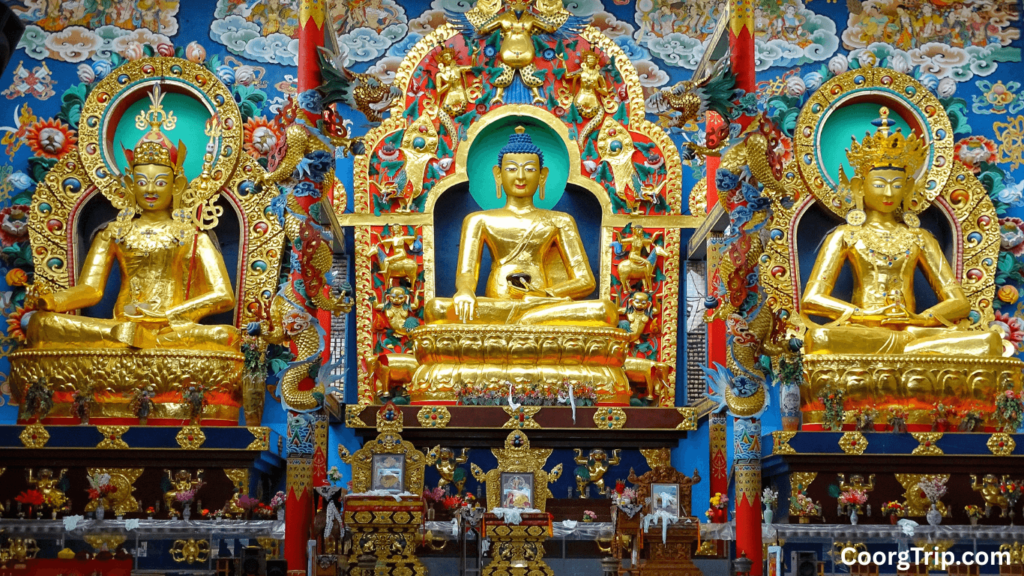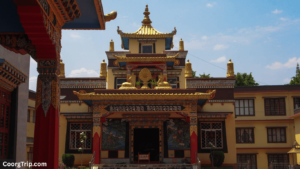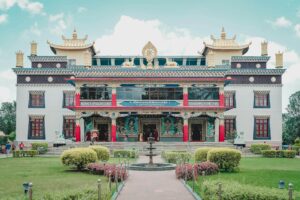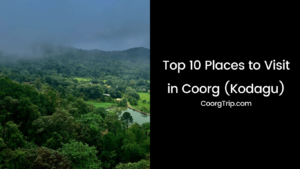
There’s a special kind of thrill in discovering a place that feels like it’s been waiting just for you. For me, that place is the Golden Temple Coorg—a breathtaking Buddhist sanctuary nestled in the lush hills of Karnataka’s Kodagu district. Over the years, I’ve wandered Coorg’s winding roads, sipped spiced coffee with locals, chased mist over coffee estates, and stumbled upon hidden corners that most guidebooks overlook.
If you’re planning your own adventure, don’t miss my ultimate Coorg travel guide—it’s packed with everything you need to explore Karnataka’s paradise.Yet, even with all that experience, nothing quite prepared me for the quiet grandeur of Namdroling Monastery, better known as the Golden Temple Coorg in Kushalnagar. It’s not just a landmark—it’s a place alive with history, spirituality, and an undeniable sense of peace.
Hidden amidst the tranquil hills of Coorg, Karnataka, the Namdroling Monastery—popularly known as the Golden Temple Coorg—stands as a beacon of peace, spirituality, and Tibetan cultural preservation. This iconic Buddhist Monastery Coorg offers visitors a unique blend of rich history, mesmerizing architecture, and profound spiritual practices. It is not only a religious sanctuary for Tibetan Buddhism but also a hub for cultural exchange and eco-tourism.
This isn’t just a travel blog—it’s an invitation to see the Golden Temple Coorg through my eyes. I’ve explored its serene paths, listened to monks share their stories, and uncovered the little details that make this Golden Temple Kodagu unforgettable.
Whether you’re a spiritual seeker, a culture lover, or simply curious about Coorg, this journey will take you beyond the usual. Expect vivid stories, practical tips, and a closer look at what makes this Coorg Monastery so unique. Let’s step into this golden sanctuary together.
Why Coorg, and Why the Golden Temple?
Coorg—officially known as Kodagu—casts a spell with its emerald hills, coffee-scented air, and waterfalls that crash like a symphony of nature. If you’re wondering where to begin, I’ve put together a list of the top 10 places to visit in Coorg—a handpicked mix of crowd favorites and hidden gems. It’s a haven for anyone who craves a break from the grind, a place where mornings are misty and evenings glow gold. Most folks head straight for Abbey Falls or Raja’s Seat, but I’ve always had a soft spot for the quieter corners. That’s where the Golden Temple Coorg shines—literally and figuratively.
Nestled near Kushalnagar, about 34 km from Madikeri, the Golden Temple Coorg isn’t your typical tourist trap. Home to the Namdroling Monastery, it is the world’s largest teaching center for the Nyingma lineage of Tibetan Buddhism. Picture golden statues towering over you, monks chanting in crimson robes, and a stillness that seeps into your soul.
My first visit to the Golden Temple Coorg was a fluke—a detour after a caffeine-fueled morning in Kushalnagar. A shopkeeper selling prayer beads mentioned a “Golden temple” so I decided to check it out. I followed a rough road, not expecting much, but what I saw left me speechless: a huge monastery shining in the middle of greenery, with golden spires glowing in the sunlight.
Since that first visit, the Golden Temple Kodagu has become an essential stop on every Coorg trip. For those drawn to serenity, culture, and hidden wonders, the Golden Temple Coorg is more than just a place to see—it’s an experience that stays with you long after you’ve left.
Unveiling the History of the Golden Temple Coorg
Let’s rewind to 1963, when Namdroling Monastery, famously known as the Golden Temple Coorg, wasn’t a tourist attraction but a sanctuary. His Holiness Penor Rinpoche, the 11th throne-holder of the Palyul lineage, arrived in India as a refugee after the 1959 Tibetan uprising. During this time, thousands of Tibetan monasteries, including his own Palyul Monastery—one of the six main Nyingma centers—were destroyed.
Amid this upheaval, he found refuge in Bylakuppe, a small town near Kushalnagar, where the Government of India allocated land to Tibetan refugees. But this was no ready-made sanctuary—just vast, untamed land, where even roads were a rarity. With nothing but determination, Penor Rinpoche and a small group of monks built the first shelter—an 80-square-foot bamboo hut for the Golden Temple Coorg. It was modest, yet it carried the weight of an entire spiritual tradition.
As the years passed, what started as a humble refuge grew into something extraordinary. By the 1970s, Namdroling Monastery had become more than just a shelter; it had evolved into a thriving center of Tibetan Buddhist learning, safeguarding the teachings of the Nyingma school within the Golden Temple Coorg. In 1983, Penor Rinpoche traveled back to Tibet, taking the bold step of reviving the Palyul tradition at its original site.
Then came 1999—a defining moment. The Buddhist Monastery Coorg blossomed into what travelers now recognize as the Golden Temple in Kushalnagar, with its grand prayer hall radiating an aura of serenity.
A Walk Through the Golden Temple Coorg

Step inside the Golden Temple Coorg, and you’re met with sheer magnificence. Towering over visitors are three colossal golden statues:
- Buddha Shakyamuni (60 feet), the embodiment of enlightenment.
- Guru Padmasambhava (58 feet), a revered figure in Tibetan Buddhism.
- Buddha Amitayus (58 feet), symbolizing longevity and wisdom.
These statues, crafted in gold-plated copper, aren’t mere decorations—they house sacred relics and ancient scriptures, carrying profound spiritual significance. Surrounding them, walls explode with color—murals depicting Buddhist deities, mythological tales, and intricate teachings, their vibrancy breathing life into every corner of this Coorg Monastery.
A Living Legacy
Today, Namdroling Monastery, the core of the Golden Temple Coorg, is home to over 5,000 monks and nuns, making it the largest Nyingma teaching center in the world. Meanwhile, the broader Bylakuppe Tibetan settlement hosts around 16,000 Tibetan refugees, creating a community deeply intertwined with the monastery’s spiritual and cultural fabric.
These numbers fluctuate, as monks complete their studies or new seekers arrive, but they reflect the monastery’s enduring role as a haven of faith and learning.
Whether you visit the Golden Temple Coorg for spiritual reflection or simply to soak in its majestic beauty, it offers more than just a sightseeing experience—it’s a journey through history, resilience, and devotion.
Golden Temple Coorg Location: Where to Find It
So, where exactly is this golden marvel? The Golden Temple Coorg (Namdroling Monastery) sits in Bylakuppe, a Tibetan settlement just 6 km from Kushalnagar and 34 km from Madikeri, the main town of Coorg. It’s close enough for a day trip, yet far enough to feel like a peaceful retreat.
(if you’re coming from Mysore towards Kushalnagar, the Golden Temple will appear before reaching Kushalnagar).
If you’re mapping out your route:
- Mysore to Golden Temple → 88 km
- Bangalore to Golden Temple → 220 km
- Mangalore to Golden Temple → 172 km
- Hassan to Golden Temple → 86 km
Bylakuppe is one of India’s largest Tibetan settlements, a place where prayer flags flutter in the breeze, and monasteries dot the landscape. It’s a different side of Coorg—one infused with Tibetan culture, spirituality, and history.
I’ve made the journey to the Golden Temple Coorg on everything from a rickety auto-rickshaw to a rented scooter, feeling every bump on the last few kilometers of uneven roads. It’s perfectly positioned to pair with nearby attractions like:
- Dubare Elephant Camp (20 km) – Elephant interactions, river rafting, and forest trails.
- Nisargadhama (7 km) – A serene river island with bamboo groves and hanging bridges.
- Harangi Dam (9 km) – A scenic reservoir with a picturesque setting, ideal for a quick visit.
- Chiklihole Reservoir (16 km) – A hidden gem, perfect for quiet sunset views and photography.
If you’re planning a Kushalnagar-based adventure, this Golden Temple Madikeri route is a must-visit. Need a plan? I’ve already crafted a “1 Day in Kushalnagar“ itinerary with this gem at its heart—don’t miss it.
Golden Temple Directions: How to Get There
Looking for the best Golden Temple Directions? From Kushalnagar, head west toward Bylakuppe—just follow the signs or ask a local sipping chai; they’ll gladly point you to the Golden Temple Coorg. It’s a quick 10-15 minute drive, though the last stretch gets narrow and bumpy.
No direct buses drop you at the gate of the Golden Temple Coorg, so your best bet is to:
- Take a cab (₹200-300 from Kushalnagar).
- Rent a scooter/bike for more flexibility to explore the area.
From Madikeri, it’s a 45-minute ride via NH275—smooth until you reach the Bylakuppe turnoff, where the road turns a bit rugged.
I still remember my first trip to the Golden Temple Coorg—I missed the turn and ended up at a roadside stall selling momos. The vendor chuckled, handed me a steaming plate, and waved me back on track. GPS helps (just search “Namdroling Monastery”), but signals can fade, so keep an eye out for the golden spires rising above the landscape.
From Bangalore, it’s a 5-6 hour drive to the Golden Temple Coorg—start early, and you’ll pass through misty coffee estates along the way.
The Heart of the Golden Temple
Why It Feels So Special

What keeps the Golden Temple Coorg in my heart? It’s the temple itself—a tall, four-story building topped with a Buddhist wheel, hiding a shining room inside. Step in, and you’re face-to-face with three huge golden statues—Buddha Shakyamuni, Guru Rinpoche, and Amitayus. They’re so big and bright, they almost feel alive, their light bouncing everywhere. The air’s thick with sweet incense, and the walls are covered in colorful paintings—dragons twisting, gods staring out, stories I’ve pieced together with a monk’s kind help.
The Golden Temple Coorg sprawls out wide—prayer rooms, sleeping quarters, gardens where butterflies flutter. It’s not some dusty old relic; it’s buzzing with life. I’ve watched young monks kick a football around, their giggles cutting through the stillness. This Coorg Monastery has a heartbeat, and that’s why it pulls you in.
Where Nature and Peace Come Together
The Golden Temple Kushalnagar isn’t just a building—it’s a vibe. Coorg’s green hills wrap it up tight, prayer flags flapping in the wind like they’re sending good wishes up high. Monks’ chants float around, steady as a pulse. I’ve plopped down on the soft, carpeted floor at the Golden Temple Coorg, letting those sounds wash over me—a quiet moment I didn’t plan but couldn’t shake.
Every season gives it a new look. From June to September, rain soaks everything, making the gardens pop with color and the air smell like fresh earth. October to March brings cool, clear days, the golden shine standing out sharp at sunset. Then there’s Losar in February or March—think Tibetan New Year with wild dances and silky banners waving.
What to Enjoy at the Golden Temple
What can you do at the Golden Temple Kodagu? It’s all about soaking it up. Here’s what I’ve learned from tons of trips:
- Relax and Think: Find a calm corner, close your eyes, and let the chants carry you away. I’ve lost track of time doing this—it’s pure peace.
- Take Pictures: Snap the big statues, wall art, or monks praying—every photo’s a keeper. My phone’s stuffed with them.
- Shop Around: Check out the little stalls outside for prayer flags, beads, or a tasty momo bite. I snagged a prayer wheel once and couldn’t stop smiling.
- Hear the Prayers: Try to catch the 1:00 PM prayer—hundreds of monks chanting together is like nothing else.
- Walk and Wander: Stroll around, feel the quiet. I love the garden at dusk best.
A quick tip: keep it respectful—speak softly, leave your shoes at the door, and ask before taking pics of people. It’s a holy spot, and that’s its magic.
Dining Around Golden Temple Coorg: A Taste of Tibetan Flavors
Just outside the monastery, a variety of eateries and restaurants offer a taste of authentic Tibetan cuisine, allowing visitors to immerse themselves in its rich flavors:
Local Tibetan Delicacies
- Thukpa – A comforting noodle soup, packed with hearty ingredients and aromatic spices, perfect for warming up after exploring the monastery.
- Momos – Soft, flavorful dumplings, available in both vegetarian and meat-filled options, served steaming hot with tangy, spicy chutney.
- Butter Tea – A traditional Tibetan drink with a distinct salty richness, deeply rooted in Tibetan culture and a must-try for an authentic experience.
Dining Experience & Practical Tips
- The food options may not be fancy, but they offer authentic Tibetan flavors that immerse visitors in the monastery’s essence.
- While many places now accept digital payments, some smaller stalls near the Golden Temple Coorg may still prefer cash transactions. It’s a good idea to carry some small denominations just in case.
- If you’re a picky eater, consider packing snacks, as food choices are limited but absolutely worth trying!
Whether you’re looking for a quick snack or a fulfilling meal, these Tibetan specialties offer a delicious way to complement your visit to the monastery.
When to Visit and Smart Tips
Golden Temple Timings
The Golden Temple Timings are 7:00 AM to 6:00 PM every day—though some say it stretches to 8:00 PM, so check when you’re there. The 1:00 PM prayer is a must if you can make it. It’s free to get in, but parking might cost ₹10-₹50.
Best Times and Helpful Hints
The best time to visit the Golden Temple Coorg is between October and March, when the weather is pleasantly cool—or during Losar, the Tibetan New Year, when the monastery comes alive with vibrant rituals, traditional music, and a deep sense of celebration. Monsoons from June to September turn the Golden Temple Coorg lush—just don’t forget your raincoat.
Need help picking the perfect month? Check my Best Time to Visit Coorg: Month-by-Month Guide. Here’s what I’ve picked up along the way:
- Pack some water and snacks; nearby food spots aren’t always reliable.
- Wear simple clothes—cover your shoulders and knees—and comfy shoes.
- Bring cash; cards won’t work here.
- Go early in the day or late afternoon to avoid crowds, especially on weekends.
The Life of Bylakuppe
The Golden Temple Coorg isn’t just a beautiful sight—it’s a lifeline. It holds Bylakuppe’s Tibetan community close, preserving their traditions through schools, a nunnery, and even a small clinic. More than 5,000 monks and nuns call this place home, from young ones in robes to elders with gentle, weathered smiles. I’ve sat with a monk over tea, listening as his quiet words, pieced together in broken English, told of a Tibet left behind. This Buddhist Monastery Coorg lives with purpose, a steady strength that carries their spirit forward.
Nearby Spots to Explore with the Golden Temple
The Golden Temple Coorg’s location makes it a perfect launchpad for exploring more of the region. Just 20 km away, Dubare Elephant Camp offers a lively contrast—watching elephants bathe and interact after the serene stillness of the monastery is a delightful change of pace. Nisargadhama, only 7 km off, features hanging bamboo bridges and riverside trails ideal for a relaxed nature stroll.
I’ve done them all in a single day—starting with the meditative calm of the monastery, followed by the playful chaos of elephants, and ending with forest silence. You can also add Chiklihole Reservoir (16 km) and Abbey Falls (38 km from Kushalnagar) for more variety.
Planning a weekend escape? Check out my Kushalnagar 2-Day Itinerary: A Perfect Weekend Getaway.
The Heartbeat of Faith

This Coorg Monastery, the Golden Temple Coorg, lives through its rituals. Every day, you hear chants—prayers to Guru Rinpoche, promises to help others—calling for kindness and clear thoughts. Festivals light it up: Losar brings dances and joy, Drubchen’s a deep ten-day prayer, Saga Dawa celebrates Buddha’s big moment. I’ve seen monks care for their people—free schools, health help—living out what they preach.
What You’ll Feel When You Visit
Stepping into the Golden Temple Kodagu changes you. You can watch Tibetan life unfold—monks praying, rituals humming—or grab a bowl of thukpa from a nearby shack. Pick up a painted thangka from the stalls outside. For photo lovers, it’s gold—morning light on the statues, monks moving through the day. I’ve walked away lighter, a little bell in my bag, my mind full of its stillness.
Why It Sticks in Your Mind
In a world full of loud trends, the Golden Temple Kushalnagar is gentle and honest. It’s not pushy—it’s powerful. I’ve sketched its towers, sat quiet in its prayers, let its peace untangle me. For nature lovers, it’s a green escape; for tourists, a dive into something different; for me, a home away from home. This Buddhist Monastery Coorg doesn’t yell—it whispers, and you can’t help but listen.
Your Invitation to Visit
Here’s the real deal: the Golden Temple Coorg is Kodagu’s golden soul—a piece of my journeys through bumpy roads and monk-shared chats. It’s not the loudest spot on your Coorg map, but it’s the deepest. I’ve stopped counting how many times I’ve stared up at those Buddhas, wandered Bylakuppe’s paths as the day fades. For people like us, it’s a quiet call—the best places don’t need to shout.
Add the Golden Temple Madikeri trip to your Coorg plans, grab a map (or just look up “Golden Temple Location”), and head out. Mix it with Kushalnagar’s wonders, bring a notebook, and see what it stirs in you. Been there? Got a story? I’d love to swap one with you.
FAQ’s
1. What is the Golden Temple Coorg, and why is it special?
The Golden Temple Coorg is the Namdroling Monastery, a stunning Buddhist sanctuary in Bylakuppe, near Kushalnagar in Karnataka’s Kodagu district. It’s special because it’s the world’s largest teaching center for the Nyingma lineage of Tibetan Buddhism, home to over 5,000 monks and nuns. I’ve felt its magic firsthand—those towering golden statues and vibrant murals make the Golden Temple Coorg a place of peace, history, and resilience that lingers in your heart.
2. Where is the Golden Temple Coorg located?
The Golden Temple Coorg sits in Bylakuppe, just 6 km from Kushalnagar and 34 km from Madikeri, the main town of Coorg. It’s a serene spot surrounded by Coorg’s green hills, easy to reach yet tucked away enough to feel like a retreat. Whether you’re coming from Mysore (88 km) or Bangalore (220 km), the Golden Temple Coorg Location makes it a perfect stop on your Coorg adventure.
3. How do I get to the Golden Temple Coorg?
Getting to the Golden Temple Coorg is simple but takes a little planning. From Kushalnagar, head west toward Bylakuppe—it’s a 10-15 minute drive or cab ride (₹200-300). From Madikeri, it’s a 45-minute ride on NH275, leading you to the Golden Temple Madikeri route. No buses drop you right at the Golden Temple Coorg, so a cab or bike is your best bet.
4. What are the visiting hours for the Golden Temple?
The Golden Temple Timings are 7:00 AM to 6:00 PM daily, though some say it stretches to 8:00 PM—check locally to be sure. I love timing my visits for the 1:00 PM prayer; the chants at this Buddhist Monastery Coorg are unforgettable. Entry is free, but parking might cost ₹10-₹50.
5. When is the best time to visit the Golden Temple Coorg?
The Golden Temple shines brightest from October to March, with cool, clear days perfect for soaking in its golden glow. Monsoons (June to September) make it lush and green—bring a raincoat! For a festive vibe, visit during Losar (February/March) when the Golden Temple Kodagu comes alive with dances and colors, as I’ve seen myself.
6. What can I do at the Golden Temple Coorg?
There’s plenty to enjoy at the Golden Temple Coorg. Sit quietly and let the chants wash over you, snap photos of the stunning statues and murals, or wander the gardens at dusk like I do. Check out the stalls outside the Golden Temple for prayer flags or momos—little treasures to take home. Just keep it respectful; it’s a sacred Coorg Monastery.
7. Is there an entry fee for the Golden Temple Coorg?
No, there’s no entry fee for the Golden Temple Coorg—it’s open to all. You might spend ₹10-₹50 on parking, though. I’ve always found it welcoming, a gift from the Buddhist Monastery to anyone seeking its peace.
8. Can I take photos inside the Golden Temple Coorg?
Yes, you can take photos inside the Golden Temple Coorg, and trust me, you’ll want to—those golden statues are breathtaking. Just ask permission before photographing monks or people, as it’s a holy space. My phone’s full of shots from this Golden Temple Kodagu, each one a memory.
9. What’s near the Golden Temple Coorg that I can visit?
The Golden Temple Coorg Location is perfect for pairing with nearby spots. Dubare Elephant Camp (20 km) offers elephant fun, Nisargadhama (7 km) has peaceful bamboo bridges, and Chiklihole Reservoir (16 km) is great for quiet views—all close to the Golden Temple Coorg. I’ve done them in a day with the Golden Temple Madikeri stretch as the heart of it.
10. Are there any festivals at the Golden Temple Coorg?
Yes, the Golden Temple Coorg lights up during festivals like Losar (Tibetan New Year) with dances, Drubchen’s deep ten-day prayers, and Saga Dawa honoring Buddha. I’ve caught the buzz at this Coorg Monastery—it’s a vibrant side of the Golden Temple you won’t forget.
11. Is the Golden Temple Coorg worth visiting?
Absolutely, the Golden Temple Coorg is a must-see. It’s not just a stop—it’s a feeling of peace, a dive into history, and a connection to something bigger. For me, this Golden Temple Kodagu is Coorg’s golden soul.



